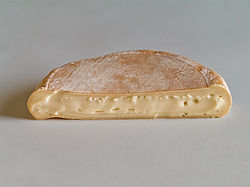In January 2012, a human case of brucellosis was diagnosed by blood culture in a district of the French Alps. The isolated strain was identified as Brucella melitensis biovar 3. Excerpts from the paper by Mailles et al. in the current issue of Eurosurveillance appear below.
In April 2012, brucellosis was confirmed in a dairy cow in a herd of the same district of the French Alps. The seropositive cow had aborted in late January, and a strain of Brucella melitensis biovar 3 was isolated from the milk sampled from the animal. The animal belonged to  a herd 21 dairy cows, and no other animal in the herd presented with symptoms suggesting brucellosis or showed any serological reaction. Approximately 20 kg of Reblochon cheese (soft raw milk cheese) are usually produced daily on the affected farm.
a herd 21 dairy cows, and no other animal in the herd presented with symptoms suggesting brucellosis or showed any serological reaction. Approximately 20 kg of Reblochon cheese (soft raw milk cheese) are usually produced daily on the affected farm.
France has been officially free of brucellosis in cattle since 2005, and the last outbreak of brucellosis in sheep and goats was reported in 2003. In order to detect and prevent any re-emergence of the disease, annual screening using Rose Bengale test or complement fixation test is carried out in all cattle, sheep and goat farms producing raw milk as well as in all cattle herds, and every one to three years in small ruminant, according to EU regulations. Moreover, abortion in ruminants is mandatorily notifiable and the investigation of abortion includes examination for brucellosis.
Reblochon cheese is a raw milk soft cheese, requiring a maturation period of three weeks to one month. The cheese from the affected farm had been commercialised after the abortion in seven districts. Cheese was sold directly at the farm, and as whole pieces or in parts in supermarkets. Cheese produced by the affected farm had not been exported to other countries but might have been bought by foreign tourists during their winter holidays in several ski resorts in the area. For this reason, the European rapid alert system for food and feed (RASFF) was informed.
After the identification of the first bovine case, the human case was interviewed again to investigate any direct or indirect epidemiological link with the infected herd. During the second interview, it became clear that the patient and their family had visited the infected farm in autumn 2011, although it was not possible to determine the exact date. During this visit, the family had bought Tome Blanche cheese, a fresh cheese obtained during the first step of Reblochon production. The four family members had shared the Tome Blanche on the same day, but the index case was the only one who later presented with symptoms.
All cheese pieces produced by the affected farm and still within the shelf life were withdrawn from retailers. In addition, a recall of already sold products was carried out via a national press release by the cheese producer and by posters in the sale points. Medical doctors in the concerned districts were informed by the regional health authorities. Consumers of these products were advised to seek medical attention should they present symptoms consistent with brucellosis.
The release of cheese from the affected farm was immediately stopped. The movements of animals from other herds that had epidemiological links with the infected herd (those that were geographically close to the infected herd, or had been bought from the infected herd) have been restricted until the end of the investigation. Furthermore, raw cheese products from farms with epidemiological links to the infected farm were put on sale only after negative bacteriological tests results had been obtained.
